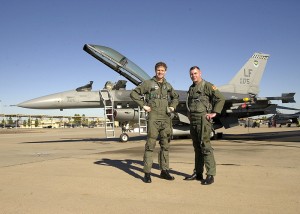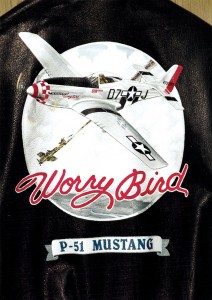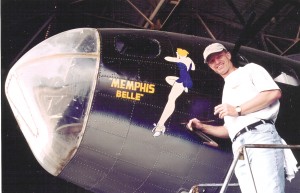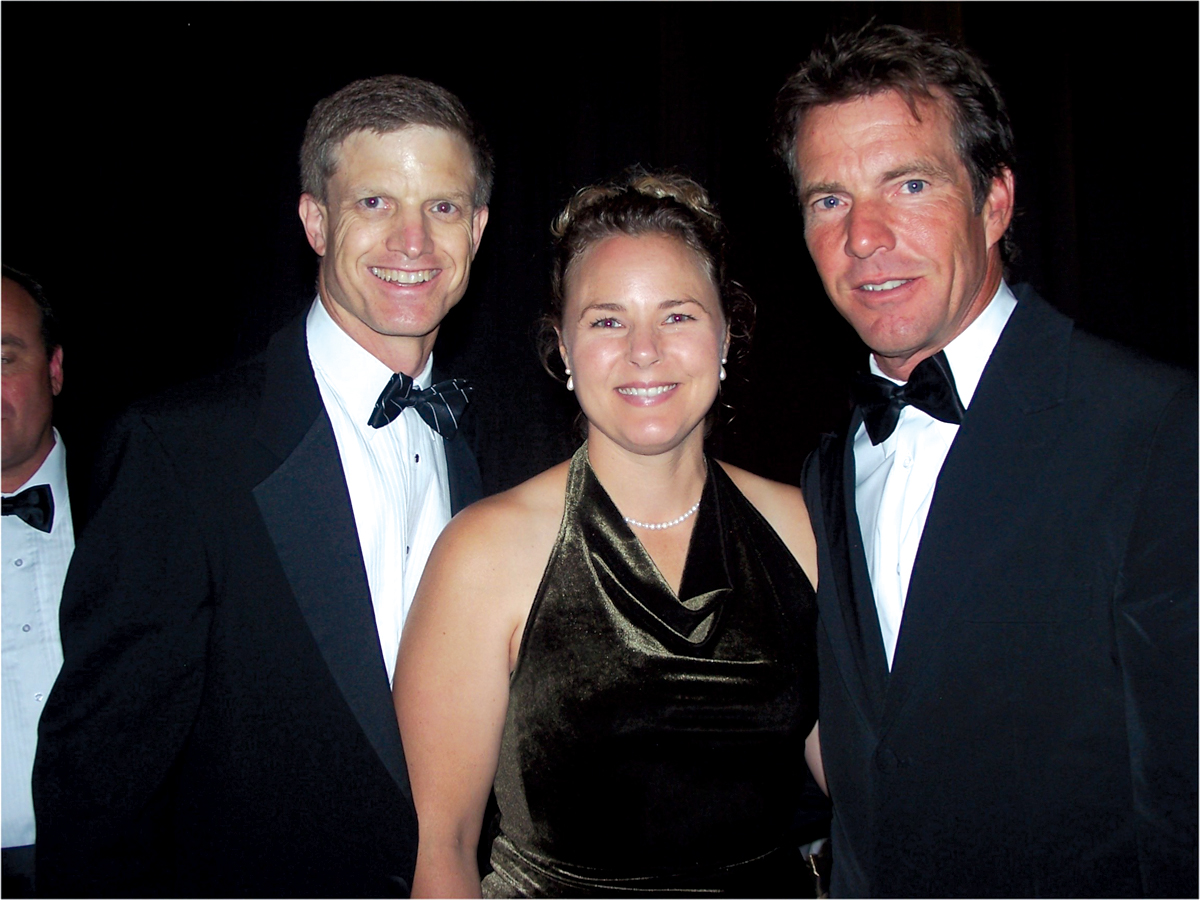By Di Freeze and Henry Holden

Ron and Jennifer Kaplan with Dennis Quaid, master of ceremonies for the 2004 National Aviation Hall of Fame Enshrinement Ceremony.
“I can’t remember a time when I wasn’t drawing airplanes,” said Ron Kaplan, the 46-year-old interim director of the National Aviation Hall of Fame.
That sometimes got him in trouble. When he was a fifth grader, his teacher admonished him for drawing pictures of Eddie Rickenbacker’s Spad in the margins of his math lessons. Luckily, he had understanding parents.
“He could be into worse things!” they responded. The drawings, as well as the response, were probably prompted by the fact that his father was a B-25 pilot in WWII, and his mother was artistic.
After his discharge from the Air Corps and later graduation from NYU as a collegiate fencing champion, the elder Kaplan became head fencing coach and later a professor Ohio State University. The college used a Beech Baron to transport professors to its various branch campuses throughout the state.
“He would often take me along, and fly as PIC to get hours, even though the university had a pilot flying with us,” Kaplan said. “We also flew for recreation in a rented single-engine university aircraft and for awhile a Baron dad had a share in.”
That spawned Kaplan’s interest in aviation. Growing up, aviation became the focus of the budding artist’s creativity.
“I knew early on that some creative endeavor would be my career path,” he said.
When Kaplan enrolled at Ohio University in 1976, he started out in communications, but switched to graphic design as a major.
“I still followed aviation through the magazines and the occasional local air show, but I moved away from it,” he said. “But my reading interests always were aviation oriented, mostly non-fiction. I’ve read some novels, but probably thousands of non-fiction aviation books.”
After two years of college, Kaplan chose to go “the entrepreneurial route.”
“I had started screen printing t-shirts and sportswear in high school,” he said. “When I left college, I continued that as a career.”
In 1982, with funding provided by some local businessmen, Kaplan founded Kaplan Graphics in Columbus. During that time, he remained somewhat involved in aviation by printing t-shirts for events like the Rickenbacker Air Show and a Doolittle Raiders reunion in Columbus, as well as doing some military work, such as t-shirts for an Air Guard unit. The company’s major focus, however, was creating t-shirts for corporate use and a line of t-shirts sold through retailers around the country. The company’s flagship line, which he started in college, and for which he still retains the trademark rights, was Surf Ohio.
“It was a spoof on surfing in locations where you obviously can’t surf,” he said. “When Surf Ohio was conceived in 1978, ‘surf’ as a fashion trend wasn’t even on the radar screen. We had just shot out of the disco era into the urban cowboy fad. Eventually, in the late ’80s, I was doing different versions all over the country (Surf Seattle, Surf El Paso, etc.).”
During the Gulf War, Kaplan created a series of t-shirts featuring aircraft from different branches of service.
“Different retailers donated the proceeds to different causes, such as the Red Cross or the USO,” he said.
In the early 1990s, his artistic talent blossomed into painting again, as a hobby.
“I hadn’t picked up a brush in years,” he said. “But I still had a pretty extensive collection of aviation books from my childhood. I also still had all my acrylic paints and brushes, so I dug them out and decided I was going to start painting at night.”
Kaplan knew he was going to have to find some subject matter to motivate him, after a full day of work. While looking through his aviation books for some inspiration, he came across nose art.
“There were pictures of Vargas pin-ups painted jackets that a lot of the 8th Air Force bomber crews wore,” he said.
Kaplan realized that was what he wanted to do. He began by painting a Vargas pin-up on the back of a leather jacket hanging in his closet. He was soon attending air shows, and painting jackets for air show performers.
Max Marion, who owned a BT-13, invited Kaplan to take pictures while he did practice flying with Bob Beckman, a T-6 owner. On a summer afternoon, Kaplan experienced his first ride in a warbird, and a taste of air-to-air photography, while in the back seat of the T-6.
“I painted Max’s BT-13 on the back of his jacket using my air-to-air photos as reference, and he became my biggest marketing tool,” Kaplan said. “He was at a different air show or flying almost every weekend. It grew from there to the point where I thought, ‘It’s a lot more fun than the screen-printing operation, and I could make more money painting jackets and nose art on aluminum.'”
In 1994, Kaplan sold his partner his share of the company. At that point, he headed down another creative airway, as an aviation journalist. In addition to his graphic design course load at Ohio University, he took communications journalism courses. As he had done in the sportswear business, he used that to his advantage in the aviation community.
Kaplan wrote freelance for different publications, and continued his artwork and marketing at air shows. He also began working as the air show photographer for Vintage Fighters owner Charles Osborn Jr. Eventually Kaplan won awards in such prestigious magazines as Aviation Week & Space Technology. He continued to promote air shows through his jacket paintings, and in the process, was invited to help Lt. Col. Dave McFarland (ret.) run the Gathering of Eagles program, which was part of graduation week events at Maxwell Air Force Base.

Ron Kaplan is a member of the U.S. Air Force Art Program, with one of his painted jackets on permanent display in the Pentagon. As part of that program, he had the privilege of flying with the 308th Fighter Squadron based at Luke AFB, Arizona.
“Several fighter aces were honored at each of the shows,” he said. “At one of these, Colonel McFarland was moderator of a seminar session held as part of the weekend’s air show activities.”
Kaplan had been doing the artwork and working with some of those fighter aces to get autographs on his artwork.
“My focus expanded, personally and professionally, from the airplanes and the artwork, to the personalities behind it,” he explained.
That started opening doors for him.
“I was meeting Medal of Honor recipients like Joe Foss, and aviation legends like Joe Engle,” he said. “It was unbelievable to be assisting and working alongside these aviation legends.”
By then, Kaplan had begun working with the Aviation Safety Institute on the concept of producing an air show that would help the nonprofit group raise money in a mission-relevant way. Through an introduction at the 1994 Dayton Air Show, which was supposed to be to find Kaplan help with his jacket business, he met Jennifer Janssens, the niece of Leo Janssens, test pilot and head of ASI. Kaplan was instantly smitten by Jennifer, who was a mechanical engineer, artist and had soloed under Leo’s tutelage, and the two married the following year.
Finding a home with the NAHF
In the early 1990s, Kaplan had approached Mike Jackson, the National Aviation Hall of Fame’s executive director, about supplying t-shirts to the 30-year-old organization. Jackson, who had been hired in 1991 to oversee the organization’s growth and fundraising toward a permanent facility, told Kaplan to come back after they had a facility—and a gift shop—and that he should keep in touch.
They remained in touch, and in 1996, as a contributing editor to Flight Journal Magazine, the new Dayton resident covered the National Aviation Hall of Fame’s annual enshrinement ceremony. He again covered the event in 1997 and 1998, and mentioned to Jackson he would like to work for the NAHF, even if it meant donning a suit and tie. Shortly after that, Jackson was in need of a new development director, whose job would be to oversee fundraising.
Although Kaplan had no experience as a development director, he was someone with a passion for aviation, knowledge, and connections. Jackson decided to train him, and Kaplan stepped into his new role in September 1998.
“I couldn’t think of another job that was more attractive or that I felt suited me more,” he said. “It just was a perfect fit. I already knew many of the enshrinees personally, and I had knowledge of many of the deceased enshrinees.” An added pleasure was learning about the enshrinees he didn’t know as much about.
With the rapid growth of the NAHF that followed, Kaplan’s role evolved. Although his focus was fundraising, his tasks included marketing and public relations for external events such as EAA AirVenture Oshkosh and the Reno National Championship Air Races and Air Show.
Once it came time to organize his first enshrinement ceremony in 1999, he realized how lucky he was to have attended three such events before. The annual event is actually a series of events, public and private, occurring over a three-day period and leading up to a black-tie gala.
“I was really pitching in and trying to learn everything I could from the talented people that had been putting them on,” he said of his participation in that event.
Fortunately, in his graphic design career and with his retail lines, Kaplan did many promotional events of his own, so he had some planning, promotion and sponsorship skills experience. He laughs and says, however, they weren’t black-tie formal dinners.
“They were outdoor rock concerts at a wave park, or on a lake,” he said.
After the 1999 enshrinement, he began talking to the staff and board about enhancing those events. Prior to 2000, the ceremonies had featured a slide show covering the lives of the enshrinees. That year, Kaplan found a local company that did broadcast quality award productions to produce mini-documentaries to show to the audience prior to a person’s induction.
“That year, we had five cameras including one on a boom, with high definition coverage,” he said.
He explained that the documentaries become part of the NAHF’s archives.
“If someone would ever want to repackage them for broadcast, they’re now broadcast quality,” he said.
Through his aviation art connections, Kaplan also secretly brought in baseball legend and Marine aviator Ted Williams. His appearance was staged to surprise everyone but specifically the ceremony emcee—former enshrinee, Marine ace, and longtime Williams pal, Joe Foss.
The success of the event prompted Kaplan to begin calling the ceremony “The Oscar night of aviation.”
2003
The year 2003 was a big one for the NAHF, beginning in January with the opening to the public of the organization’s 14,000-square-foot facility, learning and research center and exhibits. The NAHF’s mission focus shifted from being a one-event-a-year operation (followed by administering the archives) to being open year-round with over a million visitors coming through annually.
“The center’s exhibit hall, and our enshrinees and their great stories are the number one asset we have,” said Kaplan. “And of course, our living enshrinees, in particular, who are so generous and willing to help the Hall of Fame in different ways.”

Ron Kaplan’s art clients include many warbird aficionados, including Mike George of Springfield, Ill., owner and pilot of “Worry Bird,” who commissioned him to create this flight jacket featuring a restored P-51 from his aircraft collection.
That year, the NAHF would also be one of the focal points during the Centennial of Flight celebration. Because of that, Kaplan said they knew the enshrinement ceremony would have to be really special.
“In one particular brainstorming session, the late Wilkinson (“Wick”) Wright, who was the grandnephew of the Wright brothers, on our board and then my development chairman, was sitting there quietly, as he always did,” Kaplan recalled. “Then, he said, ‘Why do we have to enshrine ‘anyone’ for that special year? Why don’t we simply pause for a year and have an event honoring every enshrinee of the Hall of Fame.'”
The response was, “That makes sense.”
“That’s how it became the ‘Pioneers of Flight Homecoming,'” said Kaplan.
That gave Kaplan the opportunity to further the concept of more aggressively soliciting industry sponsorships to fund the ceremonies. Before undertaking that for the NAHF in 2000, ticket sales had largely paid for the events.
“There’s always a resistance to raising the ticket price to pay for these enhancements,” he said. “The only option we had then was to solicit sponsorships, which, today is common in the industry, especially for non-profits.”
At that same time, the NAHF was completing its $5.2 million capitol campaign.
“We needed to be careful that we weren’t robbing Peter to pay Paul,” Kaplan said.
But implementing Wick’s suggestion was a monumental task.
“I still don’t know how we pulled it off with the small staff we had,” Kaplan said. “We had a ‘reunion’ of 22 enshrinees, plus their spouses, that we had to fly in from all points, in addition to other participants. We’ll never see that many aviation legends in one place at one time again. So you can imagine the budget for an event like that! That’s why the sponsorships became so critical.”
One of Kaplan’s objectives was to make sure they had a high-profile master of ceremonies for the 2003 celebration. He thought Harrison Ford would be perfect for the role. He was soon on the phone with an acquaintance in the industry that had worked with Ford on “Six Days Seven Nights,” asking if he could help him get an invitation to Ford. That person in turn put Kaplan in touch with one of Ford’s flight instructors.
“It’s about great connectivity and the generosity of the aviation community,” Kaplan said. “It’s really like no other.”
Eventually, Ford said he’d be happy to do whatever he could to make that year’s ceremony memorable.
“He was ideal to serve in that role for us, for the Centennial of Flight,” Kaplan said. “I know he enjoyed it as much as everyone else did.”
Although it seemed like it would be hard to top 2003’s event, 2004 was also very memorable. The enshrinees were William A. Anders, the late Harriet Quimby, the late Jack L. Ridley and Patty Wagstaff. Dennis Quaid served as master of ceremonies.
Again, Kaplan’s connections helped in recruiting the pilot and actor. This time, he turned to Rob Stone, the owner of Los Angeles-based Vienna Productions, for help. Previously, he had watched a Blue Angels documentary produced by Stone, which Quaid hosted.
Stone was happy to help.
“Ron is very passionate about what he does and he’s very good at what he does,” Stone said. “Persistent is too weak a word, really. If there’s something he wants done, he makes sure it’s done, no matter what, but he goes about it in a very friendly way.”
He added that each time he’s worked with Kaplan, he feels inspired.
“You can’t help but catch his enthusiasm,” he said.
What the future holds
Mike Jackson retired at the end of 2004, leaving the role of director open. At the time, the board of directors named Kaplan interim director, but announced that they would also have to accept applications for the role and that all applicants would be reviewed equally.
Kaplan believes he’s the right person for the job. He said he’s eager to move the NAHF into the second century of flight and that he believes there’s incredible potential to be unlocked.
“I can’t think of another mission to be charged with that is so rewarding and humbling,” he said of the role of director. “It’s the ultimate honor to serve such a significant role in the preservation of our country’s aviation legacy. I believe I have the vision and the keys that will move us up and forward.”
He said the potential for the organization’s future, including its growth, is unlimited.
“There are people out there today doing things right now in aviation that are as exciting as what happened in the Golden Age,” he said. “One of the biggest challenges here is just telling the stories—about the enshrinees, but also about the National Aviation Hall of Fame—and the role we serve, chartered by Congress: To educate the public about these great Americans.”
Many other people also believe he’s the right person to move the NAHF forward.

Upon the recommendation of the Memphis Belle Memorial Association, owner and pilot David Tallichet commissioned Ron Kaplan to paint the nose art on his B-17 shortly after it received a new overall paint job in 1999.
“As far as being able to run a business and do what has to be done, I think Ron does it very well,” said Dr. S. Harry Robertson, owner and CEO of Robertson Aviation. “He’s a very honest and hardworking guy. And people like him. I’ve never known him to stretch a point or try to be a salesman, and he’s a straight shooter.”
Besides continuing in the area of fundraising, Kaplan has expanded the organization’s efforts at branding and merchandising, to generate additional revenue sources for the NAHF, as well as memberships.
“Our public service opportunities expanded,” Kaplan said. “With that, we should be also growing our membership base. That is another objective of the merchandising; it’s not just to sell cool stuff. We need to generate revenue to keep the center open, and hopefully grow the membership. Now we offer several lithographs that are autographed limited editions. They’re exclusive to the Hall of Fame; we commissioned the artwork. We also offer members a fantastic full-color quarterly magazine, Heroes & Legends.”
Kaplan said that when he goes around the country, and talks to people in aviation, they often don’t realize there is a National Aviation Hall of Fame. That’s why he constantly endeavors to promote the organization’s existence.
“Obviously, it’s tough to raise money for an organization that people have never heard of,” he said.
Because of that, Kaplan says branding is very important, but subset to that, one of his tasks is to leverage the NAHF’s assets, such as the annual ceremony.
“We have some great partnerships right now, on the marketing side with Mattel and A&E Networks, and with what you might call affiliate organizations like NBAA, and the Air & Space Museum, and with sponsors like Rolls Royce, for instance,” he said.
Ken Perich, vice president of market development for Rolls-Royce North America, said what Kaplan does for the organization isn’t just “a job for him.”
“Whenever I think about the Hall of Fame, I think about Ron,” he said. “It’s more like it’s his vocation in life. He lives it and breathes it days, nights and weekends, and whenever the need arises. His whole life revolves around the Hall of Fame.”
Branding also fits in with Kaplan’s help on various documentaries, including one directed by Isaac Mizrahi that will accompany “The Aviator” on DVD. Mizrahi is also the producer of “Chasing the Sun,” a great four-part series that aired in 2003, on PBS, with the focus on commercial aviation history. Kaplan was able to put Mizrahi in touch with various people who knew Howard Hughes or his associates, and some other museums that could help him in his research as well.
“I sent him some of the holdings we had related to Hughes’ enshrinement, and then pointed out that if he wanted to interview some enshrinees with regards to Hughes, we could facilitate that,” Kaplan said.
Mizrahi said Kaplan was very helpful.
“Particularly in helping us get to know some of these old-timers who are National Aviation Hall of Fame enshrinees who are well-known for their accomplishments in aviation,” Mizrahi said. “They were just the type of people that we needed to talk to in order to give us a sense of the period and to shed light on the role these pioneers in aviation played in making aviation what it is today.”
Kaplan said he’s excited because the documentary will promote the Hall of Fame.
“You can imagine that’s going to be a pretty good selling DVD,” he said.
Joe Suarez, a longtime colleague of Kaplan’s and the former director of the National Air and Space Society, National Air & Space Museum, Smithsonian Institute, said that people are eager to lend a hand partly because of Kaplan’s passion for flight and history.
“I’ve worked with him one-on-one when we’ve hosted guest lecturers,” Suarez said. “He may not be a university professor with a ton of degrees and academic credentials, but he understands the importance these individuals have played, and also the need to make sure the next generation understands their contributions.”
One area where Kaplan is particularly passionate is that of education. It’s no wonder, since he’s in the process of raising four boys: twins Alex and Zach, now 17, 4-year-old Maxwell and 2-year-old Mitchell.
At the NAHF Learning and Research Center, Kaplan said they have the accumulated knowledge and assets of the previous 44 years of their existence, as well as a lot of new programs that are in development.
“It’s exciting to oversee the development of our youth education program,” he said.
Mitch Carley is a big part of that development. When he was a teenager, Carley saw an ad in Rolling Stone featuring one of Kaplan’s “Surf Ohio” t-shirt creations, and had his mom write out a check. The two later met again and discovered they were both vintage aviation fans.
Since then, Carley has become a vital consultant for the NAHF’s youth education program. Carley is the creator of “Duggy the DC-3 and Friends,” a cast of “character builders that teach kids of all ages how they can learn from history and dream for the future.”
“The Duggy characters are the nucleus of SkyReach, our youth education program,” Kaplan said. “By that, I mean the kids in kindergarten through sixth grade. The program has energized everyone involved with it to date. There are some exciting announcements coming in the summer with regard to that program and taking it national. That outreach is one of my pet projects on the education side.”
It was recently announced that a “real live” DC-3 named “Duggy” will be making its first public appearance during the April 2005 EAA Sun ‘n Fun air show in Lakeland, Fla.
Carley referred to Kaplan’s “old guerrilla marketing days” and his “abilities to be a visionary and understand and see opportunity.”
“I think he’s got the passion and energy, and most importantly, the vision to see where the National Aviation Hall of Fame should grow,” he said. “There’s a spark and magic that needs to be exploited at the Hall of Fame. After all, the future of aviation is all about how to engage kids today in what the hall is about. I believe Ron is the guy to make that happen.”
S. Clayton Moore and Deb Smith contributed to this article.











